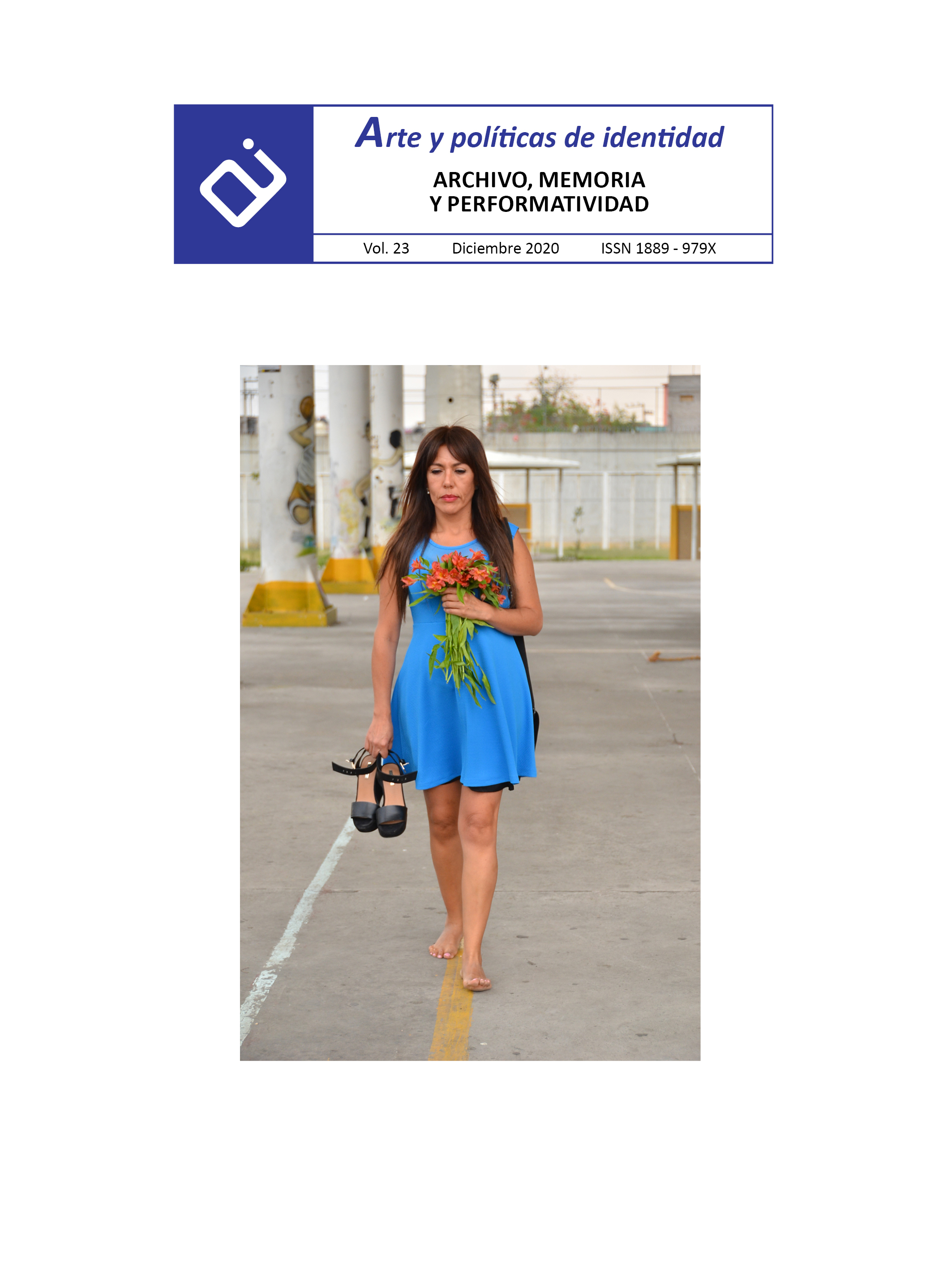The ghostly archive. Notes on Maternity as (im) possibility in the artwork of Tracey Emin
Abstract
The emergence of both the conceptual movement and the autobiographical discourse in the artistic sphere towards the
end of the sixties of the last century, entailed a split point that redefined the art work as information, significance, language and archive. In this context, the aim of this paper is to analyse the maternity as a trope that, historically, has articulated feminine reality through one brach of Tracey Emin´s artwork related to the construction of a ghostly archive about her pregnancies, her abortions and her unborned children.
Thus, from an analytical, sociological and gender critical approach, this paper ig going to analyze the perversión of the archive, memory and autobiography carried out by a ghostly narration, anchored between life and death that, paradoxically, for the artist will constitute the only way through which she can tolerate her traumatic reality.
Downloads
-
Abstract740
-
PDF (Español (España))620
References
Aguirre, K. (2019). Las madres no. Madrid: Tránsito.
Amorós, C. (1991). Hacia una crítica de la razón patriarcal. Barcelona: Anthropos.
Anderson, L. (2001). Autobiography. Londres & Nueva York: Routledge.
Arfuch, L. (2013). Memoria y autobiografía. Exploraciones en los límites. Buenos Aires: Fondo de Cultura Económica.
Badinter, E. (1981). ¿Existe el amor maternal? Historia del amor maternal. Siglos XVII al XX. Barcelona: Paidós.
Badinter, E. (2017). La mujer y la madre. Un libro polémico sobre la maternidad como nueva forma de esclavitud. Madrid: La Esfera de los Libros.
Baudrillard, J. (2000). Las estrategias fatales. Barcelona: Anagrama.
Bellucci, M. (2014). Historia de una desobediencia. Aborto y feminismo. Buenos Aires: Capital Intelectual.
Chadwick, W. (2007). Women, Art, and Society. Londres: Thames & Hudson.
Craveri, B. (2007). La cultura de la conversación. Madrid: Siruela.
Dalla Costa, M., James, S. (1977). El poder de la mujer y la subversión de la comunidad. Buenos Aires: Siglo XXI.
Derrida, J. (1997). Mal de archivo. Una impresión freudiana. Madrid: Trotta.
Duncan, C. (1982). Virility and Domination in Early Twentieth-Century Vanguard Painting. En N. Broude, M. D. Garrand. (Ed.), Feminism and Art History: Questioning the Litany (pp. 293-313). Londres: Harper and Row.
Duncan, C. (1973). Happy Mothers and Other New Ideas in French Art. The Art Bulletin, 55(4), 570-583.
Emin, T. (2005). Strangeland. The jagged recollections of a beautiful mind. Londres: Spectre. Eurípides. (2020). Medea. Barcelona: Gredos.
Foster, H. (2001). El retorno de lo real. La vanguardia a finales de siglo. Madrid: Akal.
Foucault, M. (2008). Tecnologías del yo y otros textos afines. Buenos Aires: Paidós SAICF.
Foucault, M. (2001). La arqueología del saber. Buenos Aires: Siglo XXI.
Freud, S. (2011). Tótem y tabú. Madrid: Alianza.
Freud, S. (1992). Lo Ominoso. En S. Freud. Obras Completas. Volumen 17 (1917-19) (pp. 215-251). Buenos Aires: Amorrortu Editores.
Freud, S. (1991). Recordar, repetir, reelaborar (Nuevos consejos sobre la teoría del psicoanálisis, II). En S. Freud. Obras Completas. Volumen 12 (1911-13) (pp. 145-157). Buenos Aires: Amorrortu Editores.
Freud, S. (1984). Psicología de las masas. Más allá del principio del placer. El porvenir de una ilusión. Madrid: Alianza.
Galeotti, G. (2004). Historia del aborto. Buenos Aires: Nueva Visión.
García, B. (2015). El cielo oblicuo. Madrid: Errata Naturae.
García Lorca, F. (2006). Yerma. Madrid: Cátedra.
Gilmore, L. (2001). The limits of autobiography. Trauma and testimony. Nueva York: Cornell University Press.
Guasch, A.M. (2011). Arte y archivo, 1920-2010. Genealogías, tipologías y discontinuidades. Madrid: Akal.
Guasch, A.M. (2009). Autobiografías visuales. Del archivo al índice. Madrid: Siruela.
Guasch, A.M. (2005). Los lugares de la memoria: el arte de archivar y recordar. Materia, 5, 157-183.
Lacapra, D. (2005). Escribir la historia, escribir el trauma. Buenos Aires: Nueva Visión.
Hays, S. (1998). Las contradicciones culturales de la maternidad. Barcelona: Paidós.
Illouz, E. (2007). Intimidades congeladas. Las emociones en el capitalismo. Buenos Aires: Katz.
Knibielher, Y. (2001). Historia de las madres y de la maternidad en Occidente. Buenos Aires: Nueva Visión.
Maier, C. (2005). Lo Obsceno. Buenos Aires: Nueva Visión.
Molina Petit, C. (1994). Dialéctica feminista de la Ilustración. Barcelona: Anthropos.
Morrison, T. (2014). Beloved. Barcelona: Debolsillo.
Pollock, G. (2013). Visión y Diferencia. Feminismo, feminidad e historias del arte. Argentina: Fiordo.
Rank, O. (1982). El doble. Buenos Aires: Orión.
Rosset, C. (2008). El principio de la crueldad. Valencia: Pretextos.
Rosset, C. (1993). Lo real y su doble. Barcelona: Tusquets.
Rousseau, J. J. (1973). Emilio o De la educación. Barcelona: Fontanella.
Shildrick, M. (2002). Embodying the monster. Encounters with the vulnerable self. Londres: SAGE Publications.
Trías, E. (1992). Lo bello y lo siniestro. Barcelona: Ariel.
Tubert, S. (1996). La figura de la madre. Madrid: Cátedra.
Valcárcel, A. (1997). La política de las mujeres. Madrid: Cátedra.
Vidler, A. (1992). The architectural uncanny. Essays in the modern unhomely. Massachusetts: Massachusetts Institute of Technology.
Wollstonecraft, M. (2018). Vindicación de los derechos de la mujer. Barcelona: Taurus.
Works published in this journal are subject to the following terms:
- The Service of Publications from the University of Murcia (publishing house) keeps the published works’ copyrights, and favors and allows the reuse of these works under the license indicated in point 2.
- Works are published in the journal’s online edition under the license Creative Commons Reconocimiento-NoComercial-SinObraDerivada 3.0 España(texto legal). They can be copied, used, disseminated, transmitted and publicly exhibited, as long as: i) the author and original source of publication are cited (journal, publishing house and work’s URL); ii) they are not used for commercial purposes; iii) the existence and specifications of this license are mentioned.
3. Conditions for auto-file. It is allowed and encouraged that authors share electronically their pre-print version (the pre-reviewed version) and /or post-print version (the reviewed and accepted version) of their Works before the publication, since it promotes its circulation and dissemination. RoMEO color: green.










